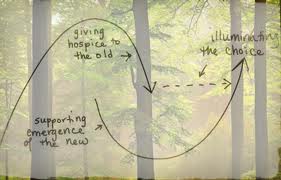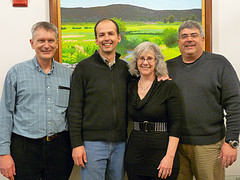In Utah for Healthier Health Care Systems Now (January 11-13, 2012), we used the 2 Loops Model of Systems Change as one of the framing references for why we were gathered. It is a tool and a framing to understand the work we are individually and collectively in that shifts the shape of health care. The two loops model looks like this:

The first loop represents the old system, the one we often name as the dying system. The second loop represents the new system, the one we keep claiming we want, the one we think cannot emerge by fiddling with the old, the one we believe is needed to bring our current systems out of crisis.
The problem is, when we begin to think about the complexity of something like health care, where there are so many jurisdictions, so many players, so many interlocking systems, trying to imagine what this new system or systems could be becomes paralyzing. The conversation often becomes philosophical and theoretical. It largely comes from an intellectual and cognitive place focused on all the things that need to shift that are outside our circle of influence.
Some of the frustration in being innovators inside of systems is that the systems begin to push back on the work in small and large ways, leading to the exhaustion, frustration and disillusionment so many leaders in health care experience. This is all part of the old narrative. Of course this showed up in our conversations in Utah to greater and lesser degrees depending on the questions, depending on who was in the conversation at any given time. Any time we were in that conversation, thinking about the new system, it didn’t feel like a new conversation.
So, how could we be in conversation about Healthier Health Care Systems Now without focusing on the second loop or the new system? Well, by remembering who we are – pioneers and innovators in health systems – working under the first loop – in the in-between spaces – championing the new or being championed. We began to focus in on and explore new questions: Where are the edges of my work? What is the new territory I could begin to walk when I go home? How can I draw on the resources in the room to expand my thinking, even turn it upside down and on its head – like the person who relies on gift economy in her practice, for her livelihood? What more becomes possible in generative spaces with other innovators? This was a different conversation, in tone, texture and energy. This one did not come from the head. It was embodied in a whole new way – the beginnings of a new narrative of health.
The awareness of the old narrative and of the stuck places infiltrated us in the best of ways at the end of the first day of our three day gathering. Someone suggested what we needed to do was create a vision of the new. Ordinarily I might agree. In this case though, that didn’t feel right. It felt like it would take us further off track given that our roomful of people were geographically stretched from coast to coast across two countries with countless “systems”?
So, without taking our eye off the intention of shifting the narrative of health, we refocused on innovating and pioneering and guerrilla tactics of hosting, collaborating and co-creating, engaging those around us in this journey that is health. We didn’t leave with a specified vision of the new system. We left heartened in our respective journeys, knowing the way to the future is through new processes, deeper conversations and finding our way with as many of our friends and colleagues as we can attract, engage and embolden along the way.
As we continue to shine the light on the experiments already underway, the successes, the challenges and the “failures”, and tap into the individual and collective resilience that is fighting to emerge, we can remember it is a journey that will shift and change as we go. We remember life actually wants to help and it wants to heal. If we focus on how to expand our individual systems of influence and share those stories with our friends, our collective system of influence automatically begins to expand. What seems like isolated work informs pockets of work elsewhere and we grow an energetic field that is part of the new, part of the second loop and is fueled by everyone stepping into innovative, courageous and pioneering ideas and projects.
I still can’t see what that second loop is for health care – other than it is about health and it is healthier. I’m not sure anyone who showed up for this conversation can see the second loop either. But I am absolutely sure that the innovators and pioneers are already prototyping what’s possible, what’s new, and in this work more and more of the new and the new narrative will show up. I am reinvigorated by what’s possible, by the people who continue to explore these questions, who challenge the status quo, despite possible personal risks in doing so and know that there are better and more healthy ways to engage health care.
I and my hosting mates are committed to convening more of these conversations with people compelled to be in them to grow the field. We envision large gatherings of people convening in new ways, continuing to innovate our way into the new system(s) so that maybe one day we will wake up and see in front of our eyes what we once thought impossible – a new generative system of health resilient enough and healthy enough to be sustainable in unexpected and beautiful ways. If we take our eyes off the urgent need for something that feels impossible and put it in the places where possibility thrives… well, what more is there to imagine or say?
- 2 loops of systems change


As usual Kathy, your writings cause me to wonder. Personally and professionally.
In this case, wondering about the effort to create change or give rise to something that is asking to be birthed. Trying to fit that to what was suggests resistance. Your visual is helpful and I will let that play in my thoughts today.
WIht gratitude for your sharing…
Thanks Anne. One of the questions that arose for me during this time was – what if everything we did didn’t change a thing, didn’t create a new system? Would I stop trying? Would any of the people I met in Utah stop trying? I know I wouldn’t. It would be amazing to completely shift the system. I think it’s possible. But if the results were simply my own motivation, simply the aha’s I see in individuals as they come back to themselves, that would be enough to keep me on my own edges of trying.
Great harvesting work Kathy! Must have been amasing to be on this edge together.
The point is that we still think that what we do individually is different than working ‘on the system’. If we change the way we work and live the ‘structures’ are changing too; but maybe the structure/system of the future will not be so solid as the structures we know. A self-organising structure is also a structure…
Thanks Ria. There is more to come — some reflections on the continued learning on hosting, some of the stories shared in Utah. Just need to find the time.
I, too, appreciate how you’ve put to words the big conversation, Kathy, as I’m know some of the participants and their work, AND it’s a similar conversation and place I am with my own workplace – a reorg in public education.
You give me nourishing food for deep thought, affirm some of what I’ve been sensing and “reacting to,” and have given a real life context for the cycle Meg Wheatley and Deborah Frieze wrote about in Walk Out, Walk On.
Bravo tutti! Thank you.
Thank you Katharine. I appreciate your reflection, particularly as I write about frameworks that are well known. I deepen my own understanding of them as I experience them, reflect on them, write on them and then have the opportunity to experience and reflect at new depths. This particularly has my attention at the moment as I reflect on where the leverage in organizations and systems is for change. Referencing Appreciative Inquiry, that would be where things are working well, although sometimes that is difficult to see when we are in the middle of them, when they don’t meet our hopes or when we are in the groan zone. Sometimes it is easiest to see how well we’ve done when we share our story and get reflections and feedback that let’s us see our work with new eyes as well as in giving us insights to grow our work and our competence. We are in a time when we need as much reinforcement of what works as possible. All of the work all of us are in contributes to the well being and advancement of the whole.
So many of our systems are “shifting shapes,” and I am grateful for the voice that you give to an individual and collective story. Thanks so much for creating a powerfully familiar story around the two loops.
My experience (and gratitude) is that our “hosting way of being together” creates spaces for appreciating and giving memory to what’s dying while at the same time invites and explores sensing and living into the new.
Beautiful and inspiring! Thank you! It inspired me for my work with strategic innovation processes. If we start walking from where we are, with the sense of walking together, we can get far.
Margaret and Ursel – and others who have responded here – your reflections are deepening the pool of wisdom and knowledge that comes from our experiences. I bow in appreciation to all of you and to the centre of this work which, if we dig deep, we see comes from source in a multiplicity of ways.
Kathy, thanks so much for articulating so well what it felt like and what it meant to be in that swoop of energy together: finding ourselves in a sort of whirlpool on the second day, then the feeling of popping out of those boxes we’d thought ourselves into on the third day, thanks to your commitment to keeping us “cooking,” and the artful visualization/dreamtime/drawing time you offered us to deepen into other ways of knowing. I look forward to more of your reflections, with great appreciation.
A bow Christy. Thank you for your words. Utah was a rich learning experience. It is still cooking as I share stories. The hosting team and everyone who showed up there were a gift and a treat! Including you.
Pingback: Hosting Lessons from the Field – Part 1 « ShapeShift
Pingback: California, Here We Come! « ShapeShift
Pingback: Slowing Down to Go Fast « ShapeShift
Pingback: Exploring How Living Systems Change | Amanda Fenton